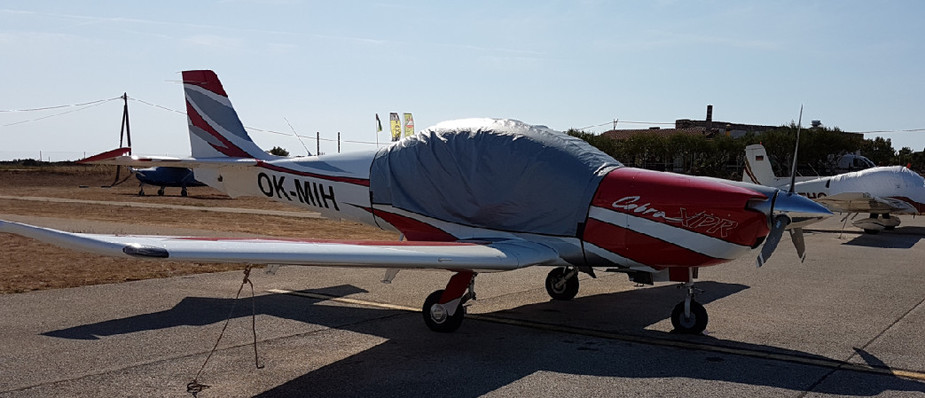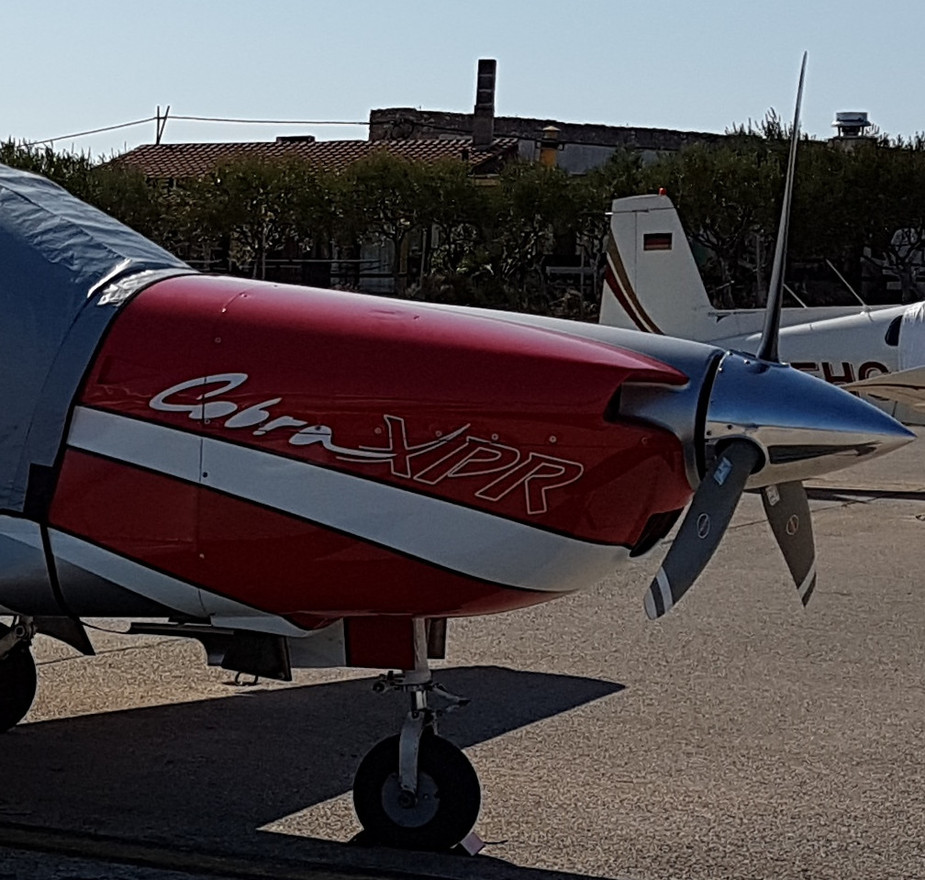It looks like OK-MIH is the only flying specimen today.
Yes, compound curves are expensive. I wonder how they did them. Either press tooling or by drawing it over a mandrel. Socata do the top cowling with a mandrel (I have seen it).
Here’s the current manufacturer’s webpage
It sure is pretty, especially when you consider much of the shape is in metal, and must have been a huge amount of work to design and produce.
I think this is the aircraft. Seen just now at Mali Losinj LDLO. It may be the only flying prototype?


I do agree with Peter that a 300k € IFR capable tourer should be possible and achievable. And I also think that a “basic IFR” fit is not a totally undesirable thing to do, if you go about it in the right way. There are several aspects to this.
1. Development and Certification.
In order to produce an airplane, it has to be developed and certified. Both are major stepping stones. Development is prohibitively costly and certification no less so. A lot of projects fail at this stage because they run out of money and time. We can see in different projects that they resort to all sort of funding, such as first producing a “kit” variant which they can start to sell and make revenue of or other ideas such as “downpayments” for delivery positions which are high risk investments to say the least both for the buyer but also for the seller who can easily end up in a situation where the downpayments are spent and no money is left to produce.
Ideally, development and certification has to be completely funded at the outset of a project. Only established companies can do that, to fund developments from the revenue of current products. For start ups, they basically need a “rich uncle” who is willing to reduce his huge wealth to a small one 
The main factor there is to figure out over how many airframes one wishes to recover these costs. That is where a lot of companies fail as well as they are WAY too optimistic about their wonderproduct. Once they discover the truth about the sales potential, they then need to rise prices dramatically in order to succeed or the original development company goes bust and development is written off and the certified airplane can be produced without the overhead of development cost by a successor company who “only” buys the design. Basically, that is what happened at Eclipse or to an extent also the Columbia/Corvalis. None of the modern makers would have survived this stage without massive cash injections by new investors including Cirrus. That is also why old but certified designs refuse to die out as the overhead of new development simply is not there to drive up the price tag.
So the first part of the airplane price is the share of development cost.
2. Labour cost.
There are certainly reasons why a lot of manufacturing these days happens in low salary countries. If one calculates the amount of man hour by airframe, the amounts become staggering very quickly. The less the salaries for equally qualified workers, the less the end cost per airframe. That is, I believe, why a lot of development happens in Eastern Europe these days. I see this here every day, I can hire a full time employee at 200 Euros per month in Bulgaria but need to pay him 2000 Euros in a normal western European country at the very least.
3. Avionic and Equipment.
For IFR, the primary hurdle there again is that you need certified avionics for everything. There is a very large potential if certification standards for private operation would be relaxed to the point where very common and successful avionics like Dynon and even the uncertified Garmin and other such units could be used. Avionics are priced equally to the total cost of the airplane, they equally need to recover development and certification. The certificate alone today drives up the cost of avionic by a huge amount.
Having said all that, I would expect that a good design of a 4 seater with proper payload and avoinics which may be produced by a strictly economical company who re-use the Pug Piper concept of taking the most affordable of everything, you could arrive with a rather attractive plane with an entry model priced at around 300k and offer additional “GT” models with more bells and whilstles for maybe 500k up to todays usual values. The market will then decide for which one it will head. Experience shows that the high cost models will be the best sellers, unless there are real good reasons to go for the smaller one.
In Europe, I would try to develop a plane answering to the typical concerns of the European private pilot.
- capable to carry four standard adults plus standard baggage plus fuel for at least 1000 NM. (400 kg traffic load)
- Mogas compatible or Diesel engine
- 160 kt optimum cruise
- MTOW below 1200 kg
- Service ceiling 18000 ft
- Max range 1500 NM.
- FIKI
- IFR
- Full airframe parashute
For the basic IFR Suite I’d go for an
- Aspen 2500 Suite (which includes 2 independent AHRS, ADC and Altimeters, so no back up needed)
- Avidyne Dual IFD440 or IFD540/440 suite with AMX340 Audio and AXP340 Transponder (or equivalent Garmin/King suite)
- KN63 DME
- Avidyne DFC90 Autopilot
- Standard engine instruments or an EDM850 if certifyable as stand alone
For a higher priced model I would offer an IO540 engine for about 180-200 kt speed, again Mogas compatible, plus the Avidyne Entegra 9 Avionic Suite.
Were it possible to fly with “non certified” avionic on private planes, I’d opt for a complete Dynon Skyview 10 suite including their autopilot.
Incidently, the same avoinic suite may well suit a lot of retrofits or re-born airframes such as the Grumman Tiger or the Mooney series…
One way to reduce individual airframe costs would also be to limit the option catalogue to relatively few but distinctive versions (e.g. either the complete “basic” suite as outlined above or the Entegra 9 or the G1000 suite, but no variants).
Built in Eastern Europe with the knowledge there, I’d be really surprised if there was no market for something like that for the price Peter mentions.
I’m familiar with small twins being used for medical repatriation, transfer of organs for transplant or radio-isotopes – but not heard of a small sep being used for these purposes and wouldn’t have expected it to catch on in a big way. In Britain, I think it’s mostly in the highlands and islands that you get a fair amount of fixed wing transfers – often not in the sort of conditions you’d want to fly in a single.
Here in Central Europe, there are also companies that operate longer-range medevac missions with Lears or Kingairs. What I doubted was the use of small (piston) aircraft for that purpose.
That aside, I always liked the design and the concept (retractable gear, metal construction) of the Cobra. If it ever comes to the market and depreciates enough to become affordable for me as an used aircraft, I’ll sure give it a close look  …
…
Fixed wing aircraft are frequently used for medevac from Mexico to the US. Typically a helicopter meets the fixed wing aircraft at the US airport side and takes the person to hospital from there. I imagine the same might be true from parts of Africa.
Its interesting to me that the Czech industry remains so proficient at metal aircraft construction. A 315 HP Cobra would be a fine plane I’m sure, and looks to have both head room and some semblance of forward view.
How can that be? I can’t see the place to fit in even a stretcher (not to speak about modern medical equipment), and the days of fixed wing air ambulances have been over for decades …
The stretcher fits in with the right seat removed. Fixed-wing ambulances are a thing of the past in the densely populated areas, but there are places in the world where a helicopter just doesn’t have the necessary range – a patient may be 300 NM away from the nearest aerodrome. Obviously, in this case there will be a doctor on board rather than a paramedic.
Another case for fixed-thing medevac is emergency repatriation. A major Czech operator of medevac helicopters occasionally uses Piper Senecas for this purpose.
it´s not certified by EASA or anyone else yet for sure.